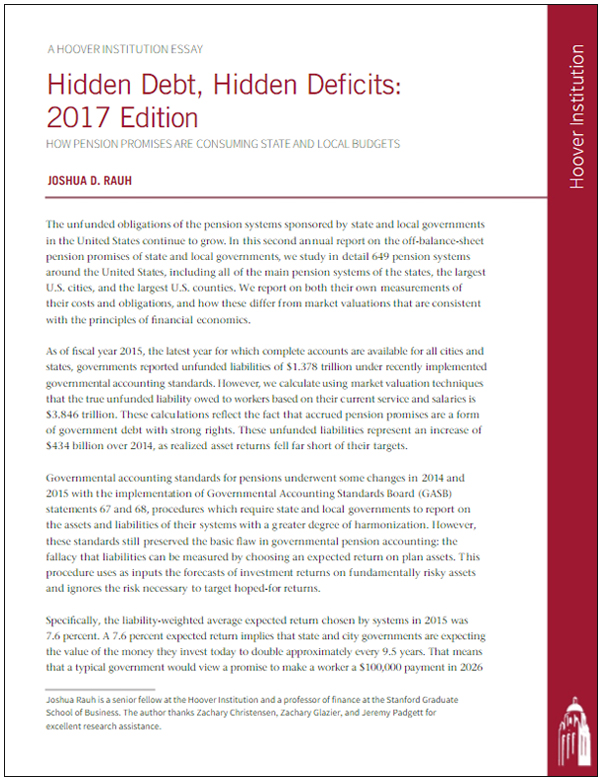The Hoover Institution Press today released 2017’s Hidden Debt, Hidden Deficits – a data-rich study by Hoover Institution Senior Fellow Joshua Rauh -- that calls attention to the fact that almost no state or local government is running a balanced budget, with the reality being that runaway pension costs are consuming state and local budgets.
Building off last year’s 2016 report, this year’s study of 649 U.S. pension systems found that systems in 2015 realized average investment returns of only 2.87%, yet the average discount rate that they chose was 7.36%. This differs from last year's report, where they realized higher average returns. This fiscal year the systems' returns were far below their average discount rate, versus last year where they were far above.
“While state and local governments across the US largely claimed they ran balanced budgets, in fact they ran deficits through their pension systems of $167 billion,” said Rauh. “This deficit equals 18.2% of all state and local government tax revenue, including that of entities that do not sponsor their own pension systems. The deficits are large and the study reveals the fact that state and local government budgets are far from balanced when one considers pension promises.”
U.S. state and local governments taken together would have needed to contribute $167 billion more than they actually contributed to prevent a rise in their net pension liabilities under the realized return. This is the "Hidden Deficit". In last year's report, the contributions were more than enough to prevent a rise in their net pension liabilities, but only because of unusually high stock market returns.
The 2017 report found that total unfunded pension liabilities rose to $3.85 trillion, which is approximately $434 billion more than last year. Of this $3.85 trillion, only $1.38 trillion is recognized by state and local governments. The rest is "Hidden Debt".
Despite the new Governmental Accounting Standard Board (GASB) guidelines, the majority of public pension systems in the United States still calculate their pension costs and liabilities using the assumption that their contributed assets will achieve returns of 7 to 8 percent a year, ignoring the enormous risks that pension funds have taken on. To target these investment returns, systems have taken increased positions in the stock market and other risky assets, including private equity, hedge funds, and real estate. The targeted returns may or may not be achieved, but public sector accounting and budgeting proceed as though they will be achieved with certainty.
Find the full study here.
Author: Joshua D. Rauh is a Senior Fellow at the Hoover Institution and the Ormond Family Professor of Finance at the Stanford Graduate School of Business. He formerly taught at the University of Chicago and Northwestern University. His research on state and local pension systems in the United States has received national media coverage in outlets such as the Wall Street Journal, the New York Times, the Financial Times, and The Economist.
About the Hoover Institution: The Hoover Institution, Stanford University, is a public policy research center devoted to the advanced study of economics, politics, history, and political economy—both domestic and foreign—as well as international affairs. With its eminent scholars and world-renowned Library & Archives, the Hoover Institution seeks to improve the human condition by advancing ideas that promote economic opportunity and prosperity and secure and safeguard peace for America and all mankind.
CONTACT INFORMATION: Marlon Bateman | Office of Public Affairs | Hoover Institution | bateman@stanford.edu | 650-723-0603























